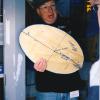Lighting the Park
During a star party some fifteen years ago hosted by George Bliven from the Frosty Drew Nature Center and conducted by Dr. Bill Penhallow an astronomy professor at URI, the idea of creating an Observatory in Ninigret Park was born. While many factors suggested this site, one of the principle attractions was its very dark skies. Well away from the lights of Providence and Warwick, with no lights at all to the south over the ocean, faint objects were visible that were hidden across almost all of the east coast from North Carolina well up into Maine. For years one of the principle attractions of Frosty Drew Observatory for amateur astronomers was its dark skies.
Light pollution has made the skies of the eastern seaboard several orders of magnitude brighter than these skies were when I was a child. The Milky Way used to be a common sight in the summer skies everywhere except the largest cities. Today only pockets in remote locations typically have dark skies. Frosty Drew Observatory is unusual in being in an area of dense population yet blessed with dark skies.
At various times, Ninigret Park hosts events that are brightly lit. The Observatory staff understands and applauds activities such as the Big Apple Circus in spite of their bright lights. During the weeks when the Park is awash with light, the Observatory limits itself to a handful of the brightest objects in the sky such as the Moon or the planet Jupiter. It is impossible to view many of the dimmer but fascinating nebulae, galaxies and star clusters when brightly lit events occur. Such events have typically been limited to a few weekends in the summer. If various Park venues such as the ball fields and the Senior Center were lit during Observatory hours, the problems of transient events such as the Circus would become permanent impediments.
Two types of light pollution are extremely harmful - direct illumination which washes the Observatory and grounds as well as lights aimed into the sky. They affect viewing in various ways. Illumination of the Observatory means that adaptation to the dark will not occur. Our eyes have two systems of vision - color vision which needs well lighted surroundings and night vision which must have dark conditions. Our night vision is what we rely upon for astronomy. The second source of pollution is at least as bad and possibly worse. Lights which aimed even slightly above the horizontal illuminate the sky with a glow that is typically several orders of magnitude brighter than a true dark sky. On a true dark sky night, stars as dim as the sixth magnitude are visible to the unaided eye. As we scan a true dark sky we see as many as two thousand stars at a time. For each magnitude we lose to light pollution we cut the number of stars in half. Neighborhood street lighting without upward shields typically illuminate the sky with a shine which is some four orders of magnitude. Anyone looking at the sky would see between 60 and 125 stars at best. The Milky Way would be invisible. Comets and auroras would be hidden.
Viewing through the telescope is severely affected. A telescope operates in two major fashions, as a collector of light and as a magnifier of a view. Magnification would be unaffected by light pollution, but the gathering of light is harmed greatly. A typical deep space object such as a gaseous nebula we look at through our telescope at Frosty Drew Observatory is 100 to 3000 times dimmer than the dimmest stars we can see with our eyes. Contrast is crucial. Even a very dim object can be distinct against a black background, but it will vanish against a grey lit background. We attempt to look at these dim objects when conditions are ideally black. However, these ideal conditions can never occur when we must compete with artificial illumination at close quarters.
We are not trying to be obstructionists. We simply cannot compete with artificial light. Imagine a farm upstream from a power dam. As the dammed lake increases it spills onto the farmer's fields. When the farmer protests, the power company offers to accommodate the farmer by dropping the level of water on the field from 10 feet to 5 feet. From the power company's viewpoint they "met the farmer half way". From the farmer's view, the field is still covered with water too deep to use. We are like the poor farmer, a sky which is only twice as bright as now is still far too bright to allow astronomy. The lights on ball fields and the Senior Center may seem only a minor inconvenience to some while to us they spell the end of public astronomy in Ninigret Park.
- Author:
- Leslie Coleman
- Entry Date:
- Jul 1, 2004
- Published Under:
- Leslie Coleman's Columns

